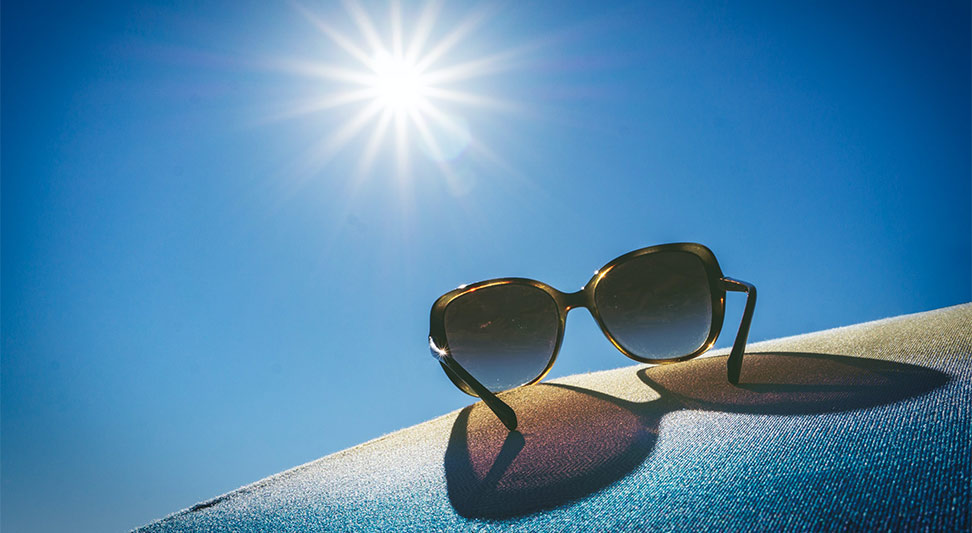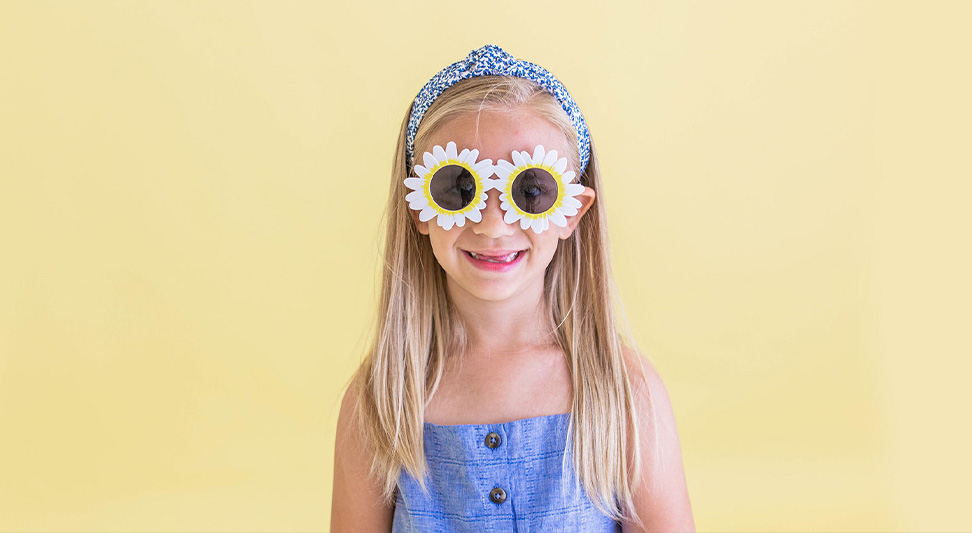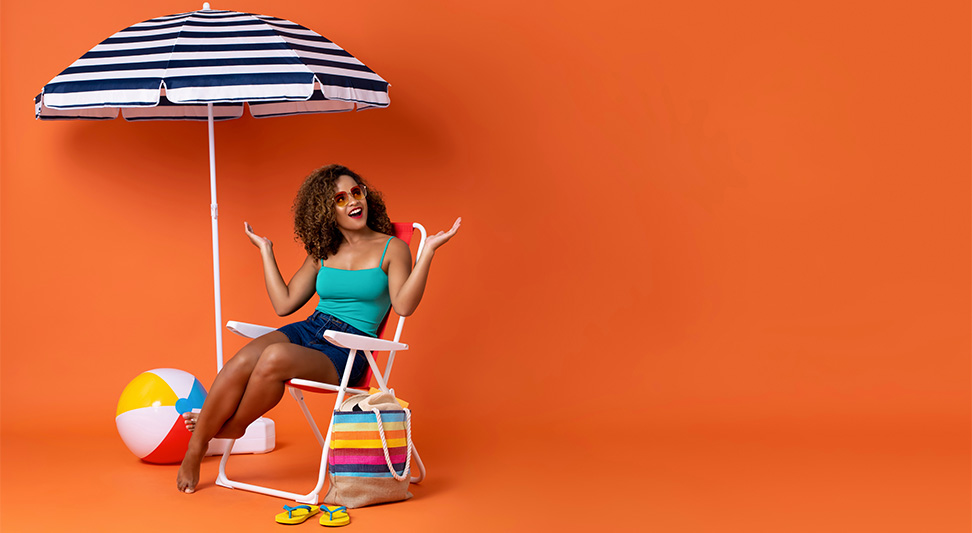The U.S. Department of Health and Human Services has named July as Ultraviolet (UV) Safety Awareness Month. They hope to help Americans like you understand the dangers of UV light exposure. While you might know the importance of using sunscreen when you go outdoors, protecting your eyes from the sun’s harmful rays is just as important.

What Is UV Light?
Ultraviolet (UV) light is a type of radiation that emanates from the sun. You can also get UV exposure from tanning beds and sunlamps. Don’t make the mistake of thinking that artificial sources of UV light are safer. They are just as dangerous to your skin and eyes as direct sunlight.
There are three types of UV light:
- Ultraviolet A (UVA)
- Ultraviolet B (UVB)
- Ultraviolet C (UVC)
UV light is classified according to wavelength, or the distance between peaks in a series of waves. UVA has the longest wavelength, and it can penetrate your skin’s middle layer. UVB has the next longest wavelength and can penetrate your outer layer of skin. UVC has the shortest wavelength, and all of the UVC rays emitted by the sun are absorbed by the ozone layer. The only way that you might be exposed to UVC radiation is from a tanning bed or sunlamp.
Wearing sunscreen and sunglasses that block 99% to 100% of UVA and UVB light will help protect you from the harmful effects of the sun. It’s especially important during the period between 10 a.m. to 4 p.m. when the UV rays are their strongest. You might think that UV exposure is only a danger during the summer months. Your risk might be greater if you spend more time outdoors during the summer, but UV rays can reach you on cloudy days, during cool weather, and during any season of the year.

How UV Light Hurts Your Eyes
UV light does have some benefits, as does spending time outdoors. For one thing, you get vitamin D from UV radiation, which aids in the absorption of calcium and phosphorus. You need vitamin D for bone development and strength. But you can get the UV needed with just 5 to 15 minutes of unprotected sun exposure 2 or 3 times per week. Anything more than that puts you at risk for several types of health issues.
Eye injuries caused by UVC can result in severe pain and the feeling of grit in your eyes. You might get this type of eye damage from lying in a tanning bed even for a short time without wearing protective goggles.
Some UVC lamps also emit a small amount of UVB light. Prolonged exposure to UVC light can lead to injuries like cataracts, eye cancer, growths on or near the eye, and an increase in the risks of developing eye cancers that are associated with cumulative UVB rays from the sun.
Accumulated UV light exposure from the sun can lead to these and other eye conditions over a period of months or years. Every time you go outdoors without proper eye protection, you increase your risk of developing serious health issues.
Unfortunately, people who wear glasses are at an increased risk of developing eye conditions because it’s not always possible to switch back and forth between eyeglasses and prescription sunglasses every time they step outside.
Summertime is LASIK Time! Schedule your free LASIK consultation and save $600 on LASIK this summer!

Protecting Your Eyes from the Dangers of UV Light
To develop best eye care practices, it’s important to dispel some common myths and misconceptions about UV eye protection.
Myth – Only Expensive Eye Glasses Really Work
You don’t have to buy expensive sunglasses for them to be effective. As long as they block 99% to 100% of UV rays, they will provide the necessary protection.
Myth – The Sun Is Only Dangerous During Hot, Sunny Days
The radiation from UV light is invisible. It’s always present during daylight even when you can’t see sunlight or feel the sun’s warmth. Eye protection is just as important when it’s cloudy, snowing, or pouring rain.
Myth – It’s Safe to Look at the Sun When You’re Wearing Sunglasses
Never look directly at the sun even if you’re wearing eye protection. This advice applies not only during full sunlight – but also during an eclipse. When you stare at the sun, the UV light enters your eye. The lens focuses the light at the retina. These rays then form free radicals that destroy the photoreceptors. You can develop a condition called “photic retinopathy” within seconds of exposure. Even sunglasses with 100% UV protection can’t protect your eyes if you stare directly at the sun.
Myth – Babies and Children Don’t Need Sunglasses
Babies and children are just as vulnerable to damage from the sun as you are, if not more so. Since some types of UV damage are cumulative, it could mean more problems later on.
Myth – Any Size Sunglasses Work Equally Well
Bigger is definitely better when it comes to sunglasses size. Wraparound styles or oversized glasses help prevent light from entering from the top and sides. The stylish oversized glasses that are so popular right now also offer your greatest UV protection!
Myth – Polarized Lenses Offer the Best UV Protection
Only sunglasses that say they offer 99% or 100% UV protection will block the UV radiation from the sun. Polarized lenses, on the other hand, block the glare off shiny surfaces like water, snow, or the hood of your car. They make you more comfortable and improve performance during sports and other activities. For optimum protection, look for sunglasses that are both UV-blocking and polarized.
Myth – Dark Lenses Work the Best
Clear lenses can be just as effective at blocking UV rays as those that are much darker. Like polarized glasses, tinted lenses give you more contrast so that you can see better during sports and other outdoor activities.
Myth – A Hat Isn’t Necessary While You’re Wearing Sunglasses
Together, UV-blocking sunglasses AND a hat provide the most protection for your eyes because the brim or bill of the hat can stop sneaky UV rays from finding their way through the gaps between your sunglasses and your face. On top of that, hats can also help keep the sun from shining directly on your face, neck, and shoulders.

What You Should Take Away from Ultraviolet Safety Awareness Month
Only you can protect your skin and eyes from the harmful effects of UV radiation. Any time you head outdoors, make sure you have three things:
- Sunscreen
- UV blocking sunglasses
- A hat
It takes all three to provide the level of protection you need for your skin and eyes. Even when you’re fully equipped, avoid going out during the middle of the day when UV rays are the strongest.
Know your risk factors. Anyone is susceptible to skin cancer, but some people have a greater risk of developing melanoma. This is the deadliest form of skin cancer. Some types of melanomas spread to other parts of the body quickly. Increased sun exposure is one of the reasons that melanoma is on the rise.
Other risk factors for skin cancer include having lighter skin, multiple moles, and people with a history of blistering sunburns. If you have light-colored eyes, light skin, or a family history of eye melanomas, you are also at a greater risk of developing eye cancer. If you have any risk factors, be extra vigilant about protecting your skin and eyes against radiation from the sun.
Do your part this July and help spread the word about the dangers of overexposure to UV light. Follow best sun protection practices and make sure everyone in your life knows what to do, too!

